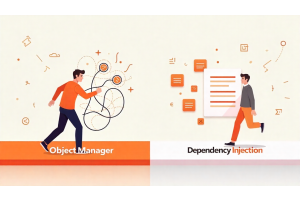How Much Does It Cost to Run a Magento Store in 2025?

How Much Does It Cost to Run a Magento Store in 2025?
Magento remains one of the most powerful and customizable eCommerce platforms in the market. Its robust features and flexibility make it the preferred choice for many merchants. However, running a Magento 2 store comes with significant costs. This guide explores the true cost of running a Magento 2 store in 2025, helping merchants make informed financial decisions and determine if it aligns with their budget.
Table Of Content
An In-Depth Look at Magento 2
Magento, rebranded as Adobe Commerce after Adobe's acquisition in 2018, remains one of the most powerful and flexible eCommerce platforms available. Despite its official name change, the developer and merchant communities still commonly refer to it as Magento 2.
Magento 2 Versions: Open Source vs. Commerce
Magento 2 is available in two primary editions:
- Magento Open Source: This free, self-hosted version gives businesses full control over development, customization, and maintenance. It’s a popular choice for small to mid-sized businesses looking to leverage Magento’s robust eCommerce capabilities without recurring licensing costs.
- Magento Commerce: A premium, fully managed solution that comes with advanced features, performance enhancements, and dedicated support from Adobe. Ideal for enterprises seeking scalability and out-of-the-box features.
Why Focus on Magento Open Source?
For most small and medium-sized businesses, Magento Open Source is the go-to solution. Its cost-effectiveness, unparalleled flexibility, and active developer community make it a compelling choice for building tailored eCommerce stores. With Magento Open Source, merchants have the freedom to:
- Customize the platform to suit their unique business needs.
- Control hosting, integrations, and ongoing optimizations.
- Leverage a vast library of third-party extensions to enhance functionality.
In this article, we’ll focus on Magento Open Source — the platform that powers countless thriving online businesses worldwide.
Magento 2 Cost Analysis: Key Components
Running a Magento 2 store involves multiple cost elements that contribute to the overall investment. These include hosting, development, extensions, marketing, and ongoing maintenance. Below is a comprehensive overview of the key cost factors:
1. Hosting Costs
For Magento Open Source, merchants must manage their own hosting solutions. Hosting costs vary significantly based on the type of hosting and the store’s needs:
| Hosting Type | Description | Cost Range |
|---|---|---|
| Shared Hosting | Entry-level solution for small stores with low traffic and fewer resources. | $10 – $30/month |
| Virtual Private Server | A dedicated virtual environment offering improved performance and control. | $30 – $100/month |
| Dedicated Server | Designed for medium to large stores with high traffic and resource demands. | $200 – $500/month |
| Cloud Hosting | Scalable, high-performance hosting suitable for growing businesses. | $100 – $500+/month |
Factors Influencing Hosting Costs
- Store Size and Traffic: Larger stores with higher traffic volumes require more robust hosting solutions to ensure smooth performance and prevent downtime.
- Resource Needs: Custom features, extensions, and large product catalogs increase server resource demands.
- Security Requirements: Higher-tier hosting plans often include advanced security features, such as SSL certificates, firewalls, and regular malware scans.
- Performance Optimization: Hosting providers may offer caching mechanisms, CDNs (Content Delivery Networks), and performance monitoring tools, all of which impact costs.
- Scalability: Growing businesses benefit from cloud hosting due to its ability to scale resources quickly during traffic surges.
Choosing the Right Hosting Provider
Selecting a reliable hosting provider is essential for ensuring performance and security. Look for providers that specialize in Magento hosting and offer features such as:
- 24/7 Customer Support: Immediate technical support to minimize downtime.
- Magento Optimization: Servers optimized specifically for Magento 2.
- Scalable Infrastructure: Ability to upgrade or downgrade hosting plans as needed.
- Backup and Recovery Options: Regular backups to protect data in case of failures.
Pro Tip
In 2025, cloud hosting continues to dominate due to its unmatched scalability, reliability, and ability to handle sudden traffic spikes without compromising performance. Platforms like AWS, Google Cloud, and Azure are leading the way, providing tailored solutions for Magento users.
2. Magento Licensing Costs
One of the significant advantages of Magento Open Source is that it is completely free to download and use, with no upfront licensing fees. This makes it an ideal choice for businesses looking to minimize initial expenses while still leveraging a powerful and flexible eCommerce platform.
However, while the software itself is free, costs arise from:
- Development: Custom development to tailor Magento Open Source to meet specific business requirements. This includes:
- Custom features and functionality.
- Integration with third-party systems (e.g., CRMs, ERPs, or payment gateways).
- Building custom themes for a unique design.
- Design: Creating a visually appealing, user-friendly storefront that aligns with your brand identity. Costs may include:
- Custom UI/UX design.
- Responsive designs for seamless mobile and desktop experiences.
- Hiring professional designers for advanced styling and branding.
- Customization: Enhancing Magento’s core functionality to meet specific business goals. Examples include:
- Developing bespoke modules or extensions.
- Adding advanced features, such as personalized shopping experiences or automation tools.
- Optimizing for speed, SEO, and user experience.
Key Takeaway
While Magento Open Source eliminates licensing costs, investments in development, design, and customization are crucial for creating a fully functional, high-performing eCommerce store tailored to your business needs. Partnering with skilled developers and designers ensures you maximize Magento’s potential and deliver an exceptional user experience.
3. Development and Design Expenses
For Magento 2 stores, development and design typically account for the largest portion of your budget. The total cost can vary widely depending on several key factors, such as:
- Custom Design vs. Pre-made Templates: Custom designs involve extensive customization, making them significantly more expensive than using pre-designed themes that are ready to deploy.
- Store Features and Functionality: The more advanced or unique features and integrations you add to your store, the higher the costs will be. This includes anything from specialized payment gateways to complex product configurations.
Development and Design Cost Breakdown:
| Development Type | Description | Estimated Cost |
|---|---|---|
| Basic Template Setup | A simple store setup using an existing pre-built theme. Ideal for businesses on a tight budget or those requiring a faster launch. | $5,000 – $10,000 |
| Custom Theme Design | A fully customized theme that aligns with your brand identity and business needs. This involves more design and development time. | $10,000 – $50,000 |
| Custom Development | Implementation of advanced features, integrations, and complex functionality tailored to your business. This is ideal for businesses with unique requirements or growth plans. | $10,000 – $50,000+ |
Expert Tip
To ensure top-quality results and avoid unnecessary costs, it's crucial to collaborate with established and experienced Magento development agencies. Their expertise can help streamline the process while delivering the best value for your investment.
4. Ongoing Maintenance, Updates, and Performance Optimization
After launching your Magento 2 store, it’s crucial to invest in continuous updates and performance optimization. This ensures that your website remains secure, functional, and up-to-date with the latest technology, enhancing both user experience and store performance. Regular updates and optimizations can also help prevent issues before they arise, keeping your store competitive in a fast-evolving eCommerce environment.
Key Services for Ongoing Maintenance:
| Service Type | Description | Estimated Annual Cost |
|---|---|---|
| Routine Code Updates | Ongoing improvements and bug fixes to your store's code to enhance compatibility, address security vulnerabilities, and incorporate the latest features. These updates are crucial for keeping your Magento store aligned with new Magento versions and third-party integrations. | $2,000 – $10,000/year |
| Performance Optimization | Focusing on optimizing your store’s speed and efficiency, such as reducing load times, optimizing images, and improving server performance. These improvements ensure a faster, more responsive shopping experience, which can directly impact your conversion rates. | Included in regular updates |
| Security Patches and Audits | Regular security assessments and applying the latest patches to safeguard your store from vulnerabilities. This proactive measure is essential for protecting sensitive customer data and maintaining trust. | $500 – $2,000/year |
| SEO and Conversion Optimization | Ongoing efforts to enhance your site’s SEO performance and user experience, helping to increase organic traffic, improve rankings, and drive conversions. This includes adjusting content, meta tags, and improving site architecture. | $1,000 – $5,000/year |
| Mobile Optimization | Ensuring that your Magento store is fully optimized for mobile devices. This involves responsive design adjustments, improved mobile navigation, and mobile-specific performance optimizations. | $1,000 – $3,000/year |
Pro Tip
Regular maintenance and optimization not only improve your store’s performance and security but also ensure it adapts to emerging trends. By consistently optimizing your store, you can stay ahead of the competition, provide a superior shopping experience, and maintain customer trust. Investing in ongoing updates is an essential strategy for long-term success.
5. Extension Costs and Considerations
Magento’s flexibility and power come from its vast ecosystem of extensions, which allow you to tailor your store with new features and enhanced capabilities. These extensions enable store owners to integrate everything from advanced payment methods to robust inventory management systems, creating a unique and customized shopping experience.
While Magento offers a variety of extensions, the right choice depends on your business needs, budget, and long-term goals. Below is a breakdown of extension types and their associated costs.
Breakdown of Extension Costs:
| Extension Type | Description | Cost Range |
|---|---|---|
| Free Extensions | Free extensions can be a good starting point, offering basic functionality. However, they often come with limitations in terms of features, updates, and support. Best for smaller stores or those experimenting with new features. | Free |
| Paid Extensions | Paid extensions provide more advanced features, frequent updates, and better customer support. These typically range from $50 to $500 per extension, with prices varying depending on the complexity and functionality offered. | $50 – $500 per extension |
| Custom Extensions | Custom extensions are designed specifically for your store’s unique requirements. These extensions are typically more expensive, as they require bespoke development to address complex functionalities or integrations. | $1,000 – $20,000+ per extension |
| Subscription-based Extensions | A newer trend in the Magento ecosystem, subscription-based extensions provide ongoing updates, support, and security patches for a recurring fee. This model ensures that your store’s functionality stays current with the latest Magento releases and technological advancements. | $100 – $1,000+/year |
Expert Tip
When selecting extensions, it’s crucial to balance your immediate needs with long-term scalability. While free extensions may seem appealing, they often lack the advanced features or support that paid or custom extensions provide. Investing in subscription-based models ensures your store remains secure and functional over time, with regular updates and customer support. Always evaluate the quality and reputation of extension providers to ensure that your investment is worthwhile.
6. Ongoing Maintenance and Support Costs
Consistent maintenance is essential for keeping your Magento 2 store secure, fast, and fully functional. Over time, the complexity of your store, the features you've integrated, and the level of support required will influence your maintenance costs. Choosing between an in-house development team or outsourcing this responsibility can further impact the overall expense.
Routine maintenance includes everything from applying security patches and software updates to optimizing site performance and troubleshooting issues. Ensuring your store stays updated with the latest technology and complies with security standards is essential to providing customers with a reliable shopping experience.
Maintenance Options and Associated Costs:
| Maintenance Option | Description | Cost Estimate |
|---|---|---|
| Outsourced Maintenance | With outsourced maintenance, a third-party service provider manages tasks such as routine software updates, security patches, bug fixes, and performance optimizations. This is ideal for businesses that don't require constant oversight or those who want to keep operating costs low. Many service providers offer different tiers of support based on the level of service required, from basic support to 24/7 monitoring. | $500 – $2,000/month |
| In-House Development Team | For businesses that require greater control, speed, and customization, hiring an in-house development team can be a viable option. An in-house team will handle everything from daily maintenance, security patch management, and troubleshooting to customizing features and integrating new technologies. This option offers faster response times and the ability to tailor your store's maintenance to your specific needs. However, it also requires a significant investment in salaries, benefits, and overhead costs. | $70,000 – $200,000/year |
| Hybrid Approach | Some businesses choose a hybrid model, which combines both in-house and outsourced teams. In this model, routine maintenance tasks, such as applying security patches and updates, are outsourced, while complex tasks, custom developments, and troubleshooting are handled by in-house developers. This can offer a balance between cost efficiency and control. | $1,000 – $5,000/month for outsourced, plus in-house salary costs |
| Performance and Security Audits | These specialized audits are essential to ensure your site is secure from vulnerabilities and is performing at its best. Regular security audits can help identify potential risks before they become significant issues, while performance audits can pinpoint slowdowns or bottlenecks that affect the user experience. Typically, these audits are conducted quarterly or annually, depending on the complexity of the store. | $1,000 – $5,000 per audit |
Additional Considerations for Maintenance Costs:
- Frequency of Updates: The more frequently you need updates, custom features, or bug fixes, the higher your maintenance costs will be, especially with an in-house team.
- Custom Features: If your store includes unique, complex features or integrates with multiple third-party systems, ongoing maintenance and troubleshooting may be more intensive.
- Security: Magento stores are frequent targets for cyberattacks. Proactive security measures, such as regular vulnerability assessments and patch updates, are crucial. These can add additional costs but are necessary to protect customer data and avoid costly breaches.
- Software Compatibility: Keeping your Magento 2 store compatible with various versions of PHP, MySQL, and other components may require more specialized expertise, which could increase maintenance expenses.
Pro Tip
Whether you choose to outsource or hire an in-house team, regular communication and clear expectations are essential. Outsourcing can be an ideal solution for smaller stores or those with limited budgets, while an in-house team may be better suited for businesses with complex needs or those looking for rapid response times and deeper customization. Consider a hybrid approach for the best of both worlds, with the flexibility to scale as your store grows.
7. Security Investment for Magento Stores
While Magento 2 offers a strong security foundation, implementing additional measures is crucial to safeguard sensitive customer data and ensure compliance with industry standards. Investing in security tools and services helps protect your store from cyber threats, build customer trust, and avoid costly data breaches.
Security costs can vary depending on the complexity of your store, the level of protection required, and the specific features or compliance standards you need to meet. Below is an overview of common security investments for Magento stores.
Key Security Measures and Their Costs:
| Security Measure | Description | Estimated Cost Range |
|---|---|---|
| SSL Certificate | An SSL certificate encrypts data during transmission, ensuring that sensitive information like credit card details and personal data remain protected. It’s essential for building customer trust and is often required for e-commerce websites. | $50 – $300/year |
| Security Extensions | These extensions add an additional layer of protection by monitoring your store for potential vulnerabilities, malware, and other threats. They can include features like two-factor authentication, bot protection, and firewall management. | $100 – $500/year |
| Security Audits & Penetration Testing | Conducting regular security audits and penetration testing by specialized experts helps identify vulnerabilities within your store’s code, server, and network. These tests simulate potential attacks and help pinpoint weaknesses before malicious actors can exploit them. | $500 – $5,000/year |
| PCI Compliance | Achieving and maintaining PCI DSS (Payment Card Industry Data Security Standard) compliance is necessary for any store processing credit card payments. It ensures your store meets industry standards for secure payment processing. | $1,000 – $10,000/year |
| Firewall & DDoS Protection | Implementing a web application firewall (WAF) and DDoS protection helps block malicious traffic, prevent attacks, and ensure your store remains available during high-volume traffic events or cyber threats. | $500 – $2,000/year |
| Backup & Disaster Recovery | Regular backups and a solid disaster recovery plan ensure that your store can recover quickly from data breaches or technical failures. Backup systems should include automated solutions that store data securely offsite. | Varies |
Additional Security Considerations:
- Real-time Monitoring: Continuously monitoring your store for suspicious activity or potential breaches can help identify issues in real time. Services that offer 24/7 monitoring typically involve higher costs but are essential for high-risk or large-scale stores.
- Security Updates & Patches: Magento frequently releases security patches to address new vulnerabilities. Ensuring that your store stays updated with these patches is essential for maintaining a secure environment.
- Employee Training: Educating your internal team on best practices for security—such as creating strong passwords and recognizing phishing attacks—can be a valuable preventive measure.
Pro Tip
Prioritize security from day one and allocate resources for ongoing protection. Security is an ongoing effort, not a one-time expense. Regular audits, SSL certificates, and compliance checks will save you from potential financial and reputational damage down the line. Investing in a multi-layered security strategy ensures that your Magento store stays protected against evolving threats.
8. Payment Gateway Fees and Costs
Payment gateways are an essential component for processing transactions in your Magento 2 store, enabling secure and seamless payments from customers. However, payment gateways come with a range of fees, which can impact your overall operating costs. These fees typically fall into three categories: setup fees, transaction fees, and subscription fees. Understanding these costs can help you select the right payment processor for your business.
Breakdown of Payment Gateway Costs:
| Fee Type | Description | Estimated Cost Range |
|---|---|---|
| Setup Fees | Some payment gateways charge a one-time setup fee to configure and integrate the payment processor with your Magento store. These fees cover initial configuration, account verification, and necessary configurations for secure payment processing. | Up to $500 (one-time) |
| Transaction Fees | These fees are typically charged as a percentage of each transaction. They cover the cost of processing the payment securely and transferring the funds to your account. Transaction fees vary based on the payment gateway and the type of transaction (e.g., credit card, digital wallets). | 2.5% – 3.5% per transaction |
| Subscription Fees | Many payment gateways require a monthly or annual subscription fee for ongoing access to their services. These fees cover system maintenance, customer support, and access to features such as fraud prevention, recurring billing, and multi-currency support. | $20 – $100/month |
| Cross-Border Fees | If your store processes international transactions, some payment gateways charge additional fees for currency conversion or cross-border payments. This cost is usually a percentage of the transaction value. | 1% – 3% per transaction |
| Chargeback Fees | If a customer disputes a charge and a chargeback occurs, payment gateways may impose fees. These fees help cover the administrative costs involved in resolving disputes. Chargeback fees can vary depending on the gateway and the nature of the dispute. | $15 – $50 per chargeback |
Additional Payment Gateway Costs:
- Fraud Prevention Tools: Many payment gateways offer fraud detection services, which may be an additional cost. These tools help identify suspicious transactions and prevent fraud, saving you from potential financial losses.
- Integration Fees: Some payment gateways may charge for integration with your Magento store, particularly if you need custom solutions or third-party connectors.
- Refund Fees: While refunding a customer is often necessary, some payment processors may charge a fee for processing refunds, which could impact your margins.
Pro Tip
Carefully evaluate your payment gateway options based on the nature of your business and customer base. For high-volume stores, transaction fees can add up quickly, so negotiating lower rates or selecting a gateway with flexible fee structures can make a significant difference. Additionally, consider the additional services each gateway offers, such as fraud prevention and multi-currency support, to ensure you choose a solution that fits your long-term needs.
9. Marketing Expenses for Magento Stores
Effective marketing is critical for driving traffic, enhancing brand visibility, and boosting conversions in your Magento 2 store. Marketing costs can vary widely depending on the type of campaigns, services, and platforms you choose. Whether you're focusing on SEO, paid ads, or social media strategies, understanding the different marketing channels and their associated costs will help you allocate your budget wisely.
Overview of Marketing Costs and Strategies:
| Marketing Activity | Description | Estimated Cost Range |
|---|---|---|
| Search Engine Optimization (SEO) | SEO involves optimizing your website to improve its visibility in search engine results. This includes on-page SEO (content, structure, and meta data), off-page SEO (backlink building), and technical SEO (site speed, mobile optimization, etc.). A well-executed SEO strategy can significantly increase organic traffic and long-term sales. | $2,000 – $10,000/month |
| Content Marketing | Content marketing focuses on creating valuable, informative, and engaging content to attract and retain customers. This can include blogs, videos, product guides, infographics, and more. Quality content helps build brand authority, drive traffic, and improve customer loyalty. | $1,000 – $10,000/month |
| Pay-Per-Click (PPC) Campaigns | PPC campaigns involve paying for ads on platforms like Google Ads, Bing, or social media. You pay each time someone clicks on your ad, which drives immediate traffic to your site. PPC is ideal for businesses looking for fast results and targeted traffic. | $50 – $10,000/month |
| Email Marketing | Email marketing allows you to reach out to your customers with personalized content, product offers, and news. Platforms like Mailchimp, Klaviyo, and Constant Contact enable you to run targeted email campaigns to nurture leads, drive sales, and increase customer retention. | $50 – $500/month |
| Social Media Marketing | Social media marketing involves running paid campaigns or organic strategies on platforms such as Facebook, Instagram, Twitter, and LinkedIn. Paid social media ads allow for hyper-targeting based on demographics, interests, and behavior. Organic strategies focus on building engagement and community. | $200 – $10,000/month |
| Influencer Marketing | Partnering with influencers to promote your products can provide a powerful boost to your brand’s reach and credibility. Costs vary depending on the influencer’s following, engagement rate, and content type. | $500 – $20,000+/campaign |
| Affiliate Marketing | This marketing strategy involves partnering with affiliates who promote your products in exchange for a commission on sales. It’s a performance-based model, making it a low-risk way to drive sales. Costs include commissions and potentially setup fees for affiliate networks. | 10% – 30% commission per sale |
Additional Marketing Considerations:
- Branding and Creative Services: High-quality design assets, like logos, banners, and video production, are crucial for a cohesive brand identity. Creative costs can vary based on the complexity and type of content.
- Conversion Rate Optimization (CRO): Investing in CRO services helps improve the efficiency of your existing traffic by optimizing your site’s user experience. This can include A/B testing, funnel analysis, and on-site behavior tracking.
- Seasonal and Event-Based Campaigns: Running special campaigns around holidays or key events (e.g., Black Friday, Cyber Monday) often requires increased marketing budgets to stay competitive.
Pro Tip
Diversifying your marketing strategy is key to sustained growth. While SEO and content marketing offer long-term benefits, PPC and social media ads can provide immediate results. Make sure to regularly assess the performance of each channel to ensure your marketing budget is delivering optimal returns.
10. Human Resource Costs for Magento Stores
Operating a Magento store requires a skilled team of professionals across various functions to ensure the store runs smoothly, delivers a great customer experience, and meets business goals. From developers and designers to marketing experts and support agents, each role plays a critical part in the store’s success. The salary ranges for these roles can vary based on experience, location, and industry demands.
Breakdown of Key Roles and Salary Expectations:
| Role | Responsibilities | Annual Salary Range |
|---|---|---|
| Magento Developers | Magento developers are responsible for building and maintaining your eCommerce site, customizing features, ensuring site performance, and implementing any necessary integrations. A strong understanding of PHP, MySQL, and Magento’s architecture is essential for this role. | $70,000 – $200,000/year |
| Web Designers | Web designers focus on creating a visually appealing and user-friendly interface for your Magento store. They handle the layout, design elements, branding, and overall aesthetic of the website. Designers are also responsible for ensuring the site is responsive and optimized for all devices. | $50,000 – $150,000/year |
| Digital Marketing Experts | Digital marketing professionals are responsible for driving traffic to the store and converting visitors into customers. This includes executing SEO strategies, running PPC campaigns, managing email marketing, and handling social media marketing. Their expertise helps increase sales and brand visibility. | $50,000 – $170,000/year |
| Customer Support Agents | Customer support agents are crucial for providing assistance to your customers, managing inquiries, handling complaints, and ensuring a positive customer experience. They act as the frontline of your business and help maintain customer loyalty. | $40,000 – $80,000/year |
| Project Managers | Project managers oversee the entire development process, ensuring that projects stay on track, deadlines are met, and resources are allocated efficiently. They are responsible for coordinating between developers, designers, and marketing teams to ensure smooth operations. | $60,000 – $120,000/year |
| Quality Assurance (QA) Specialists | QA specialists are responsible for testing your store’s functionality, identifying bugs, and ensuring everything works seamlessly. They play a key role in maintaining the store’s reliability and minimizing downtime. | $50,000 – $100,000/year |
Additional Human Resource Considerations:
- Freelancers and Contractors: Depending on your store’s size and budget, you may opt for freelancers or contractors for specific tasks, such as temporary design work, ad-hoc development, or seasonal support.
- Training and Professional Development: Investing in your team’s skills and expertise through training, certifications, and industry conferences is essential for keeping up with the rapidly evolving eCommerce landscape.
- Outsourcing: If you’re operating on a limited budget, outsourcing certain roles—like customer support or development—can be an effective solution. Outsourcing can help reduce overhead while still maintaining expertise.
Pro Tip
Building a strong team is critical to the long-term success of your Magento store. While hiring full-time experts can be expensive, consider a hybrid approach with a mix of in-house and outsourced roles to maintain flexibility and manage costs. Ensure your team members have the tools and support they need to grow and thrive in their roles.
Additional Expenses for Magento Stores
Running a Magento store comes with a variety of costs beyond the core development, marketing, and staffing expenses. These additional costs are essential for ensuring smooth operations, optimizing store performance, and maintaining security. From domain registration to specialized software tools, it’s important to account for these hidden costs to properly budget for the overall success of your eCommerce business.
Overview of Additional Costs:
| Cost Category | Description | Estimated Cost Range |
|---|---|---|
| Domain Registration | Every Magento store requires a registered domain name for branding and access. The cost varies based on domain extension (e.g., .com, .store) and the domain registrar you choose. This is a recurring fee that needs to be renewed annually to maintain ownership. | $50 – $200/year |
| Web Analytics & Performance Tools | Analytical tools are essential for tracking website performance, customer behavior, and marketing campaign results. Tools like Google Analytics, Hotjar, or SEMrush provide valuable insights to optimize site performance, user experience, and conversions. Advanced tools or premium subscriptions can significantly impact your marketing strategy and decision-making. | Up to $1,000/month |
| Staff Training and Development | To keep your team up-to-date on the latest Magento features and best practices, investing in staff training is crucial. This could include formal workshops, online courses, or attending conferences. Training ensures that your team is proficient with the platform, understands the latest updates, and follows industry standards for eCommerce operations. | Up to $1,000 (one-time) |
| Backup and Disaster Recovery | Regular backups and disaster recovery solutions are critical to protect your store’s data from potential risks such as server failures, cyberattacks, or accidental loss. Many hosting services offer backup options, but additional third-party solutions may be necessary for comprehensive data protection. | $100 – $500/year |
| Licensing Fees | If your Magento store uses third-party software or custom-built extensions, you may incur licensing fees. These fees ensure that you’re legally allowed to use specific tools, features, or integrations on your site. | $50 – $2,000/year |
| Legal and Compliance Fees | Ensuring that your Magento store adheres to legal requirements such as data protection regulations (e.g., GDPR) or payment industry standards (e.g., PCI compliance) is crucial for avoiding penalties. Legal consultations and compliance checks may be necessary to maintain your store’s security and compliance status. | $500 – $5,000/year |
| Customer Support Tools | To manage customer inquiries efficiently, many Magento store owners invest in tools like Zendesk, Freshdesk, or other helpdesk software. These tools streamline communication, track support tickets, and improve response times. | $50 – $500/month |
Additional Considerations:
- Content Delivery Network (CDN): To speed up your website’s loading times globally, a CDN service like Cloudflare or Akamai can distribute your content across multiple servers worldwide. This ensures faster access for customers, improving user experience and SEO rankings. | $20 – $200/month |
- External Hosting: Some Magento stores require dedicated hosting, VPS, or cloud solutions to ensure optimal performance. While Magento can run on shared hosting, stores with higher traffic may need more robust hosting solutions for stability and security. | $100 – $500+/month |
- Third-Party Integrations: Many stores need third-party software integrations for payment gateways, shipping, accounting, or ERP systems. These integrations often come with additional costs, including setup, configuration, and maintenance fees. | $500 – $5,000+/year |
Pro Tip
While these additional costs might seem small compared to core expenses like development and marketing, they play a significant role in the long-term performance, security, and scalability of your Magento store. Prioritize the most essential tools and services to balance costs while maximizing your store’s efficiency and growth potential.
Tip
To enhance your eCommerce store’s performance with Magento, focus on optimizing site speed by utilizing Emmo themes and extensions. These tools are designed for efficiency, ensuring your website loads quickly and provides a smooth user experience. Start leveraging Emmo's powerful solutions today to boost customer satisfaction and drive sales!
Conclusion
Running a successful Magento store involves more than just initial setup and development. From design and development to ongoing maintenance, security, marketing, and staffing, each cost contributes to the overall performance, scalability, and long-term success of your eCommerce business. By carefully budgeting for essentials like custom themes, hosting, extensions, and advanced marketing strategies, you can create a robust and competitive online store that meets customer needs and drives revenue.
Additional expenses, such as analytical tools, training, compliance, and customer support, may seem minor, but they play a critical role in optimizing user experience, ensuring security, and enhancing operational efficiency. Regular updates, performance optimization, and the adoption of new technologies are also key to keeping your store fast, secure, and future-ready.
To maximize your return on investment:
- Work with reputable Magento development agencies for high-quality results.
- Invest strategically in marketing, security, and performance enhancements.
- Continuously optimize and upgrade your store to adapt to changing trends and customer demands.
By addressing all aspects of cost and value, you can transform your Magento store into a thriving, scalable eCommerce platform that stands out in a competitive market and delivers an exceptional customer experience.
FAQs
What are the main costs involved in running a Magento store in 2025?
The main costs involved in running a Magento store in 2025 include development and design, hosting, extensions, maintenance, security, payment gateway fees, marketing, and human resources. Each of these areas contributes to the total operational cost of your store.
How much does it cost to develop and design a Magento store?
Development and design costs for a Magento store can range from $5,000 to $50,000 or more, depending on whether you use a pre-made theme or opt for a custom design with advanced features. Custom development also adds to the cost.
What are the hosting costs for a Magento store in 2025?
Hosting costs for Magento 2 can range from $100 to $1,500 per month, depending on the scale of your store and server requirements. Cloud-based hosting solutions may offer more flexibility but can be more expensive.
What is the cost range for Magento extensions?
Magento extensions can range from free to $500 or more per extension. Custom-built extensions tailored to specific business needs tend to cost significantly more, often starting from $1,000 and going upwards.
How much should I budget for ongoing Magento store maintenance?
Ongoing maintenance costs can range from $500 to $2,000 per month if outsourced, or up to $200,000 per year for an in-house development team. Regular updates and optimizations are necessary to keep the store running smoothly and securely.
What are the security costs for a Magento store?
Security costs can range from $50 for SSL certificates to $10,000 annually for PCI compliance. Additional costs for security audits, penetration testing, and security extensions can range from $100 to $5,000 a year, depending on your needs.
What are the typical payment gateway fees for a Magento store?
Payment gateway fees typically include setup costs (up to $500), transaction fees (2.5% – 3.5% per transaction), and subscription fees ($20 to $100 per month), depending on the provider and volume of transactions.
What are the marketing costs for a Magento store in 2025?
Marketing costs can vary significantly, with SEO services costing $2,000 – $10,000 per month, PPC campaigns ranging from $50 to $10,000 per month, and social media marketing expenses between $200 to $10,000 per month, depending on your strategy and scale.
What human resource costs should I expect for managing a Magento store?
Human resource costs depend on the roles required. Developers typically earn $70,000 – $200,000 annually, while designers range from $50,000 – $150,000. Marketing experts cost between $50,000 – $170,000, and support agents range from $40,000 – $80,000 annually.
Are there any additional costs for running a Magento store in 2025?
Additional costs can include domain registration ($50 – $200 per year), analytical tools (up to $1,000 per month), and staff training ($1,000 one-time). These costs ensure proper store management, tracking, and team readiness.




